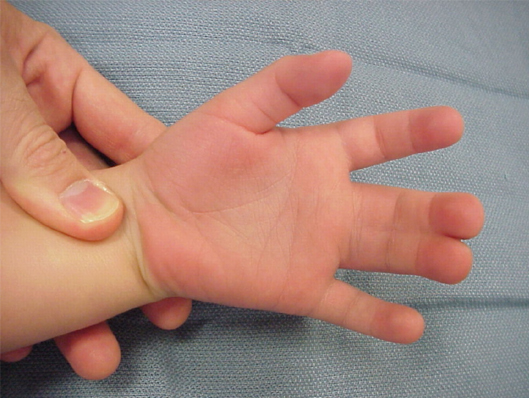
What is syndactyly?
Syndactyly is the abnormal connection of 2 fingers. Most commonly, it is a webbing between 2 fingers- the middle and ring fingers. However, it can involve any two fingers or can involve the thumb and pointer finger. It can also involve more than 2 fingers. The webbing can involve the entire 2 fingers or just involve part of the fingers. It can be just skin or can involve the bone also.
Why does syndactyly happen?
Most types of syndactyly happen during the development of the hand and arm. The entire arm forms between 4 and 8 weeks of gestation- this means that by about 56 days after the baby is conceived, the hand is in its final shape and form (although a lot smaller!). During the final developmental phases nearing 40 days and after, the fingers are all webbed. Normally, the skin interconnections disappear before 56 days but, if the cell signaling doesn’t happen like it should, the skin connections (the webbing) stays and that is what we call “syndactyly.” In most cases, there is nothing a mother or father did to cause this abnormality and there was nothing that he or she could have done to prevent it.
Constriction band (amniotic band) syndrome is another possible cause of syndactyly. In this case, we believe the hand and individual fingers form normally but then there is a trauma/ scarring s by a constriction band leading to scarring and the syndactyly. Many times the hands in this kind of syndactyly may have short fingers due to fingertip amputations.
Symbrachydactyly is another type of syndactyly. In this case, the fingers are short and webbed. Kids with symbrachydactyly can be very different from each other- some have almost normal fingers, some have short and completely webbed fingers, and some have really no fingers at all.
Definitions:
Syndactyly: Fingers that are joined together, with skin and possibly bony connections.
Partial vs. Complete Syndactyly: Syndactyly can involve the complete fingers (all the way to the tip) or just part of the fingers (partial).
Cutaneous vs. Complex Syndactyly: Cutaneous (or “simple”) syndactyly implies a skin connection only whereas a complex syndactyly includes bony interconnections between the fingers.
Complicated Syndactyly: Syndactyly associated with a syndrome (usually a situation with other health issues).
Function and Appearance:
Typically, children with syndactyly function well although the more fingers that are affected, the more difficult function may be. The primary functional problem in syndactyly is grabbing large objects or grabbing circular objects (because the fingers don’t spread apart as well as they normally would). The hand looks different with syndactyly. This may bother the child and may change how others relate to the child. In some kids, this may lead to stress and decreased self-esteem.
Surgery:
The only way to correct syndactyly is through surgery. The timing of surgery depends on many different factors. When the syndactyly involves the thumb and pointer finger or the ring and small finger, we try to perform surgery early- often by 6 months of age. Other syndactylies can be treated when the child is older, often between 12 and 18 months of age.
Separating fingers is not as simple as cutting the skin connecting the fingers (there is not enough skin and the syndactyly will reform). Instead, the syndactyly must be reconstructed through a series of carefully designed flaps. New skin must be brought between the fingers- sometimes this requires skin grafts. We try to and can usually avoid skin grafts when we reconstruct syndactyly. Kids are usually placed in bulky soft dressings until 4 weeks after surgery and then they start therapy. Therapy helps keep the scars soft and also helps to regain motion.
Plastic Surgen , Dr. Sandeep Kansal is a consultant Plastic-cosmetic Surgeon in Meerut. He is currently practicing at , Kailashi Superspeciality , Lokpriya And Nuteema Hospital in Meerut.
Copyright © 2023 Dr Sandeepkansal. All Rights Reserved.